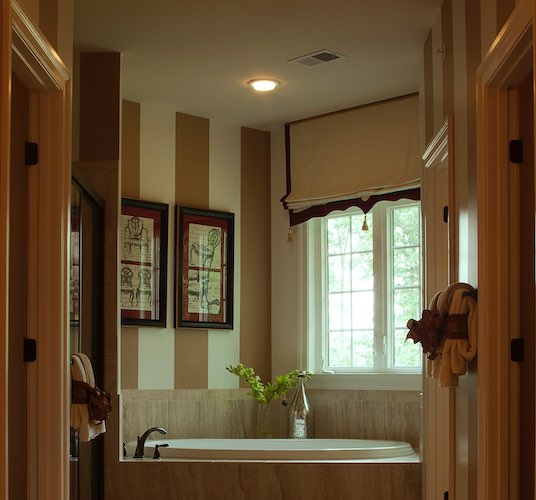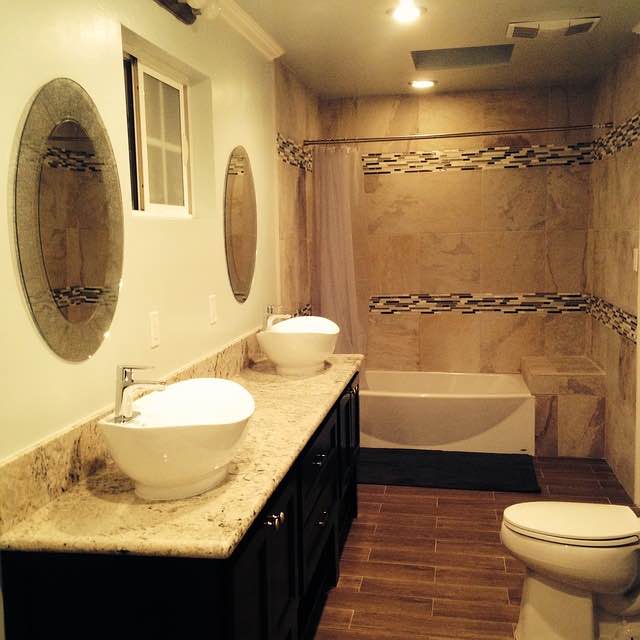Bathroom Exhaust Fan Installation | Milwaukee
We can help install your Bathroom Exhaust Fan. Give us a call today to chat about your needs.
Or read on for more info about bathroom exhaust fans and step-by-step installation instructions. We’ve installed hundreds of exhaust fans and would be happy to help with yours.
Overview: Bathroom Exhaust Fan Installation
 A bathroom exhaust fan is crucial for creating a healthy environment in your home. Not only does it keep your bathroom free of steamed-up mirrors and icky odors, but most importantly it expels humid air.
A bathroom exhaust fan is crucial for creating a healthy environment in your home. Not only does it keep your bathroom free of steamed-up mirrors and icky odors, but most importantly it expels humid air.
The consequences of not having a bathroom fan are bad: dangerous mold and mildew will have an ideal environment in which to grow, paint and drywall will crack and peel, and you may have to deal with the consequences of other bathroom moisture-related issues.
If your home does not have a bathroom exhaust fan, this is a project you’ll want to put at the top of your fix-it list. If you are fairly confident in your home improvement skills, installing a home exhaust fan yourself should not be terribly difficult. Follow our step-by-step directions below or give us a call to set up a professional installation today.
Choosing the right exhaust fan for your bathroom
Bathroom exhaust fans differ by the amount of air they move per minute, known as the “CFM” rating. A quick calculation will help you figure out what rating is right for your space. Simply multiply the square footage of your bathroom by 1.1.
You will also be able to choose the loudness of the fan, or “sone” rating, anywhere from 0.5 sone to 6.0 sone. For reference, a typical fridge runs at around one sone.
General installation tips
- Before you get started, it is important to do your due-diligence to ensure your bathroom exhaust fan will be vented out of the best location for your home. The steps below are for an exhaust fan that vents out of the sidewall but you may choose to vent through the roof or out through your home’s soffit.
- Because of the moisture level of the exhaust, a bathroom exhaust fan must always vent outdoors and never into the attic, basement, or crawlspace.
- Each bathroom in your home must have its own exhaust fan.
- Have a friend or family member help you with this project; you’ll be glad to have an extra set of hands
- Read all installation directions carefully and take your time.
Installation step-by-step
Step 1: Get organized by gathering your materials
Start your bathroom exhaust fan installation project off on the right foot by gathering all necessary materials. These can be purchased at a home improvement store like Home Depot or Lowe’s.
- Bathroom exhaust fan (see above for directions for calculating the CFM rate you will need)
- Flexible ductwork – enough to connect from the bathroom ceiling to exit point
- Pencil
- Electric drill with 3/8-inch extra long spade bit
- Tape measure
- Framing square
- Drywall saw, jigsaw, or reciprocal saw
- Goggles
- Respirator
- Duct elbow (90 degree, 4 inch)
- Foil duct tape
- Drywall screws
- 4-inch hole saw
- Foam-rubber gasket
- (4) 1 and 1/2 inch screws
- Wire nuts
Step 2: Turn off power and choose a location for your fan
Turn off the power to the bathroom where you will install the fan.
Grab your pencil and mark the bathroom ceiling where you would like the exhaust fan to be. Ideally, this would be somewhere between the toilet and shower.
Use your electric drill and extra-long spade bit to drill a hole through to the attic. This will help you find the installation location when you get up above the ceiling.
Crawl up into the attic and find your reference hole. Clear out any debris or insulation around the hole and determine if this location will work. Ideally, the fan will be located between wooden joists that can be used to secure the fan. If the location has changed from your reference hole, drill a new one.
Step 3: Trace and cut the exhaust fan intake hole
Go back to the bathroom and find your reference hole. If you had to drill a new one, make sure you are working with the correct hole.
Measure inside the exhaust fan’s intake hole and use a pencil and a framing square to trace out a rectangle matching those measurements in the location on the ceiling where the fan vent should be.
Put on your goggles and face mask and use your drywall saw to remove this section of ceiling. Be careful not to let the cutout piece fall away from the ceiling, lest it tear away surrounding plaster or drywall with it.
Step 4: Position and secure the fan
Get back up in the attic attach the duct elbow to the exhaust fan housing using foil duct tape.
Position the fan between the joists and over your exhaust fan ceiling hole. Secure the metal brackets to the joists using drywall screws.
Connect the flexible duct that came with the wall cap kit to the elbow you previously attached to the exhaust fan and secure with foil duct tape.
Snake the new or existing electrical cable through the connector and secure with a screw.
Step 4: Cut an exit hole
Next, stay in the attic to prepare the exit hole in your home’s sidewall. Find the location where you want the exhaust to leave your home – ideally at a location you can access from outside, between 2 studs and within 6 feet of the exhaust fan.
Make a reference hole and move to the outside of your home to make the cut.
Use a 4-inch hole saw to cut in through the side wall to make the exit hole.
Step 5: Affix the exhaust duct to the exit cap and wall hole
Go back into the attic to connect the flexible ductwork to the exit cap. Secure with foil duct tape.
From outside the house, pull the exit cap through the wall hole and position it tightly against your home’s siding. Cut a foam-rubber gasket to fill in any gaps between the cap and siding.
Use a small amount of silicone adhesive to position the cap and (4) 1 and 1/2 inch screws to fasten.
 Step 6: Connect the wires
Step 6: Connect the wires
Go back to your bathroom to access the exhaust fan housing. Unscrew and remove the blower motor, set the screws to the side.
Remove the built-in receptacle from inside the exhaust fan to access the electric wiring. Set screws to the side.
Connect the same-color wires from this electrical site to the electric cable you snaked through in a previous step – black to black and white to white. Secure with wire nuts.
Step 7: Secure the ceiling grille and test your fan
Plug the blower motor back into the electrical receptacle inside the exhaust fan and resecure with the screws you set aside.
Mount the exhaust fan’s plastic grille to the fan housing.
Return power to the bathroom and test your exhaust fan.
Looking for help with installing an exhaust fan in your bathroom?
If you are a home DIY enthusiast with a bit of patience and focus, you can install your own bathroom exhaust fan. However, this is certainly not the easiest of projects and involves a lot of tools, physical movement, and can be easy to do incorrectly.
If you are looking to install a bathroom exhaust fan with ease and peace of mind, call in the experts at Best Handyman Milwaukee today.
